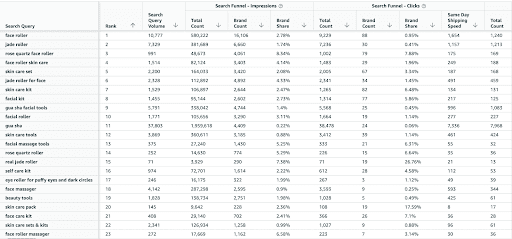As you may have noticed, a lot has been changing on Amazon in the last few months.
From the layout of the advertising console to the new business reports updates (which can be understood here) the team at Amazon have been hard at work with plenty of new features in the mix.
Last year alone, Amazon invested more than $18 billion in logistics, tools, services, programs, and teams to help Amazon sellers.
One of the most recent updates, which we are especially grateful for at Clear Ads, is the update to brand analytics to include ‘Amazon Search Query Performance’ (SQP).
Whilst this update isn’t monumental in terms of the space it takes up on the platform and can be missed if you are not looking for it, there are a plethora of uses for it that can make an astronomical difference to your performance on Amazon.
How to find Amazon Search Query Performance
In order to have access to this feature, your Amazon account must be a brand, as this is necessary to benefit from Brand Analytics. Alongside this, you must have permissions to “Amazon Brand Analytics” in the Global User Permissions page, which can be given to you by your Primary Account Administrator if you don’t have access.
In order to get to see your Amazon SQP, open your Seller Central account and navigate to the ‘Brands’ tab, clicking on ‘Brand Analytics’ in the drop down. This will take you to a screen like below, in which you can see the green bar and click on ‘View Search Analytics’.

Within this section, you have two available tabs, ‘Search Catalog Performance’ and ‘Search Query Performance’, we will be focussing on the latter in this blog, though you should play around with both when you get the chance.
What does it all mean?
When arriving onto the Amazon SQP page, initially you will be met with a long list of terms which should be very familiar to your brand and product range. For example, for a client who sells skincare tools like jade rollers, the below image shows their results.

This essentially is a breakdown of all of the search terms that are associated with your brand, ranked in order of relevance. As described by Amazon themselves, SQP ‘provides visibility into your search term’s performance based on shoppers’ search behaviour.’ This is for a set period of time over a reporting range that can be decided by you.
As you will see, the column headings may seem relatively complex and hence for any metrics that you don’t understand, you can click on the small question mark and you should be taken to another page that will explain them in-depth.
You can order the search terms from highest to lowest – and vice versa – for the metric of your choosing by clicking the arrow next to the title of the header you want to toggle with.
How can this be used?
This information can be used in a multitude of ways which are detailed below:
1. Analytics
From this data, you can understand a lot about your performance and brand. It provides insights into high-performing keywords for your products, which can be invaluable to adapting your marketing and general Amazon strategy.
2. Listing Optimisation
As a result of the terms listed being the most relevant and useful for your brand, you can utilize them to ensure they are being implemented in your listings. We would recommend you find those that are highly relevant and have the highest Search Query Volume and add them to the backend of your listing, as well as the description and title. This should help with your SEO and therefore your organic ranking.
3. Advertisement
In addition to adding terms to your listings, you can also add them to your advertising campaigns.
For example, for the terms that are at the top, you should be attempting to rank highly on these. You can check the ranking on each keyword by going onto Helium 10’s Cerebro tool, typing in your ASIN and searching for the keyword. This will show you the term and both its organic and sponsored rank.
For those with a poor ranking, you should try to improve this. This may take shape by adding all of the most relevant, highly ranking keywords to their own ranking campaigns on seller central. I would recommend naming this in a way that will be remembered as coming from brand analytics, in order to track them better (e.g. by adding SQP to the end of the naming convention).
Ranking campaigns should follow the form of having low bids on the keywords but super high Top of Search placement bids. This will allow you to only appear at the top of the search for the keyword. In turn, this should also have an impact on organic rank, which should improve as sponsored rank does and more products are ordered.
Conclusion
In conclusion, Amazon’s Search Query Performance tab can be utilized to better your stance on Amazon, as well as making you more aware of your best keywords that you can capitalize on. Look out for more blogs from Clear Ads, as we are continuously adding the newest updates from Amazon and how you can utilize them for your benefit on the platform.


